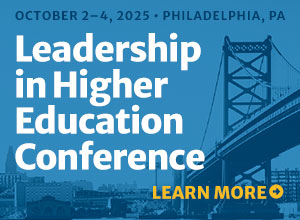How to Evaluate Your Faculty Development Services
Faculty developers across the nation are working on developing methods to evaluate their services. In 2010, the 35th Annual Professional Organizational and Development Network Conference identified assessing the impact of faculty development as a key priority. It was this growing demand that spawned my interest in conducting a 2007 statewide and...
A Centralized Approach to Supporting Experiential Learning
Wartburg College in Waverly, Iowa, has a centralized office to foster experiential learning across disciplines. This administrative structure, which grew out of a Lilly Vocation Grant, offers several advantages over more traditional, decentralized support structures.
I Love You, You’re Perfect, Now Change
An amazing metamorphosis sometimes affects academic leaders between the time they interview for the job and the time they begin their position. As candidates for the position, prospective administrators are usually overwhelmed by the quality of the students and faculty. They’re impressed by the curriculum and mission of the institution,...
Using Academic Retreats to Enhance Academic Affairs Performance
Every academic leader invests time in strategic planning groups, presidential cabinets, councils of department chairs, dean’s council meetings, and similar regularly scheduled meetings. Academic leaders occasionally leave the campus for meetings of professional societies or to participate with other academic leaders in retreats. What few institutional leaders do is develop...
Overcoming the Challenges to Effective Faculty Development
Faculty development now more than ever is necessary to an institution’s viability. But as my fellow faculty developers know, the task is not an easy one. Before any effective program can be implemented, three major challenges must be overcome.
Effective Transitioning to College Teaching: Part 2
Fourth, no matter how well intentioned and no matter how much material is covered, student learning will be severely limited by lack of retention. Retention in learning must be built into syllabus construction and course delivery from the first day of class. A useful guide to have all new faculty...
Effective Transitioning to College Teaching: Part 1
In recent years, there has been more attention given to the reality that most PhD programs do not prepare future faculty for college teaching. Even when college teaching is addressed, it is frequently in the context of sharing insights in teaching subject matter from innovators in the various disciplines. So...
Establishing a Quality Faculty Mentoring Program
Teaching at the collegiate level is a wonderful yet complex career. We hire people and expect them to teach effectively, publish frequently, serve as effective committee members, and maybe even serve as successful administrators. How many new hires on your campus arrive fully prepared and competent to fill that job...
Informal Faculty Leadership: Spreading Innovative Teaching
There’s a long-standing tradition of informal sharing of pedagogical innovation among K-12 teachers and a whole line of research on this phenomenon, which is known as teacher leadership. The same type of informal faculty leadership exists in higher education as well, but there is very little research on this topic....
Fostering Strategic Autonomy
In geopolitical terms, the phrase strategic autonomy is often used to describe the desire of countries such as India and Turkey to negotiate treaties and engage in military activities without regard for the dictates of a stronger ally or superpower. In corporate or academic terms, strategic autonomy (along with its less mellifluous...












